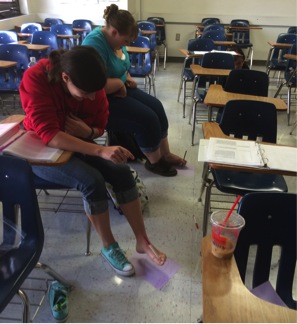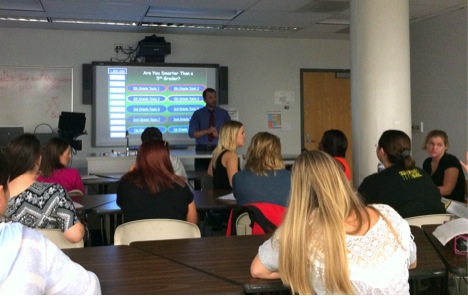 School name: Metropolitan State University of Denver (MSU Denver)
School name: Metropolitan State University of Denver (MSU Denver)
Type of college/university: MSU Denver is a large state university focused on teaching at the undergraduate level. We follow, what you may call, the teacher-scholar model.
School locale: Metropolitan city in the Rocky Mountains.
Classes you teach: Educational Psychology, Research Methods, Senior Thesis, Multivariate Statistics, and Cognitive Development. (All at the undergraduate level. )
What’s the best advice about teaching you’ve ever received?
I have had some great mentors in the past (Yes, that’s you Doug Woody, Mark Krank, Mitch Handelsman to name a few) who have given me outstanding advice. First, play to your strengths. That is, if you are an outstanding storyteller—tell good stories. If you are great at devising learning activities—use them a lot and effectively. If your heart is in the research—find ways to demonstrate this to students. Second, everything that you expect of your students, they should expect of you. For instance, in all of my syllabi I have a list of student expectations (as many of you do) but correspondingly, I have a list of expectations that students should have for me (see below). In essence talk-the-talk and walk-the-walk.
Tell us about your favorite lecture topic or course to teach.
It is always Information Processing Theory (IPT) no matter the course. Because I teach to students who will become teachers themselves, I find IPT to be easily applied to students directly. Students can not only experience working memory, or levels of processing, or attention deficits through active learning techniques, but I also love to teach them learning strategies that they may use in my class and in other courses. After this lesson, I always feel elated because it is like a gift that keeps on giving.
 Describe a favorite in-class activity or assignment.
Describe a favorite in-class activity or assignment.
I have so many favorite activities, but one that always is successful is on fine and gross motor skill development. As mentioned previously, most of my students will become elementary teachers; therefore it is important that they know what their students will experience when developing these skills. And because these skills often develop early with no memory of the experiences, my students have difficulty identifying and understanding certain fine and gross motor skills (e.g., learning to write). To get students to remember (cognitively, physically, and emotionally) what it was like to learn these skills, I ask for student volunteers to remove the shoe and sock of their least dominant-foot (i.e., if they are right handed, then their left foot). Then students are asked to first write their name at the top of the paper, then to draw a self-portrait with a marker or crayon (see pictures above). Next, I collect all of the drawings and share them with the class. I then show the class several drawings of 4-year-olds who were asked to complete the same task, except with their hands, not their feet. Students then discuss how similar and dissimilar the drawings are, what they felt while they were drawing (they often report feeling uncomfortable and embarrassed). My students notice how this may relate to children going through fine and gross motor development. Finally, as a class we debrief and share our experiences. Students often tell me how amazing it was to experience what the trials and tribulations of learning to write will be like for their students.
What teaching and learning techniques work best for you?
I like so many. When it comes to pedagogy and teaching techniques, I take the kitchen-sink approach and vary my instructional strategies. I often use the flipped lesson design, or case studies and elementary classroom observations, or cooperative learning techniques (e.g., jigsaw), or classroom assessment techniques (e.g., the one-minute paper). Currently, one of my favorite techniques is one Bethany Fleck and I created called Active Reading Questions (ARQs). Essentially, we have students answer lower and higher level questions about an assigned reading and at the end of the ARQ students have an opportunity to tell us what they are still struggling with. They complete the ARQ before class and we open each class with what the students have told us what they are struggling with. In essence, this is the starting point for the lesson. We find that ARQs allow students to understand course content at a deeper level because they come into class with a basic understanding of the material.
Three words that best describe your teaching style.
Active, Passionate, Skilled!
What is your teaching philosophy in 8 words or fewer?
Always be prepared, student-centered, compassionate/sensitive, scholarly, and adaptive.

Tell us about a teaching disaster (or embarrassment) you’ve had.
First, I can’t believe I’m about to tell this story, Second, WARNING VIEWER DISCRETION ADVISED. Third, The day I received the most wonderful news that I had won STP’s Jane S. Halonen Teaching in Excellence Award (yes, revel in the irony after reading), my educational psychology students were giving mock 4th grade social studies lessons based on Howard Gardner’s theory of Multiple Intelligence. Each group was assigned a “type of intelligence” to teach the lesson using their assigned intelligence (e.g., linguistic, naturalistic, visual-spatial, bodily-kinesthetic, etc.). While observing the musical intelligence group give their lesson, the lead group member (mind you that 99% of my students are female and this was the one male student in the class) of the visual-spatial intelligence lesson came up to me and asked, “We have PowerPoint presentation that we would like to use. Can you load it onto your computer? Here is my flash-drive.” INSERT DRAMATIC PAUSE. I obliged and put his flash drive into my computer while task-switching by watching the musical intelligence lesson. All of a sudden I heard mumblings and snickering in the back of the class. Then clear as day I heard a woman say, “Oh my!” then another woman say, “Well that looks uncomfortable” then another woman say, “I didn’t know that was possible”. I turned around to face the front of the class and to my horror projected onto the screen were 20 1ft X 1ft pictures of, let’s say adults with all of their bits and parts exposed engaged in activities that you do when all of your bits and parts are exposed! I instantly ripped the flash-drive from my computer, told the student that his group will just need to tell us about their lesson, then apologized to the class. The male student then said to the class, “I’m sorry I found this flash-drive on campus. I didn’t know that was on there.” In my mind I said, Sure you did buddy! but I just looked at him and said, “Please stop talking.” With the weight of what just happened in the pit of my stomach I continued the class for the remaining 60 minutes. It may have been the longest most uncomfortable 60 minutes of my life! Following the end of class, I immediately went to my chair and told him all about what happened. After he recovered from laughing so hard that he snorted tea out of his nose, we devised a plan on how to mitigate the issue and make sure no students were still distressed. To this day, my students still talk about that experience. MORAL OF THE STORY: Never let a student hand you a flash-drive to put into your computer. Instead, ALWAYS have students email you their presentation!
What is something your students would be surprised to learn about you?
Because I am a developmental educational psychologist I use a lot of personal examples in how I socially, cognitively, emotionally, and physically developed. Sometimes I use pseudonyms sometimes I don’t. When talking about social development I often talk about my identity development. I went through a lot of different ones. For instance, I used to be a professional rodeo athlete, was an environmental activist, had long hair, was a small business owner, and worked construction. These aspects of my life always throw off students. Sometimes students don’t believe me until I show pictures. J
What are you currently reading for pleasure?
Probably my favorite author is Sherman Alexie. I am currently reading his books The Lone Ranger and Tonto Fistfight in Heaven and The Absolutely True Diary of a Part-Time Indian. However, like my friend Eric Landrum, I have a hard time reading for pleasure. I tend to watch movies and TV shows. Currently, I am on a binge of Game of Thrones. People, “Winter is Coming!”
What tech tool could you not live without?
Oh…there are so many. Mainly, I like to use Twitter (@AaronSRichmond) to send interesting current info to my students. Or I use Celly (https://cel.ly/) in my course. My students are becoming more and more resistant to email (OH THE IRONY!), so I use Celly to text my students without knowing their cell numbers or my students not knowing my cell number. It is brilliant! Thanks @Sue_Frantz!
What’s your hallway chatter like?
Here at MSU Denver we have a very large department that is quite collegial. Although we all have disparate schedules, we have a tendency to do more than just a little bit of water cooler chatter. It typically centers on how best to help students learn (seriously), lamenting about how there is never enough time in the day, or how one another explored the beautiful state of Colorado over the weekend. However, each month or so, I arrange a departmental social hour off campus and many of us get together to enjoy each other’s company and some adult beverages.
PSYCHSESSIONS UPDATE: Listen to Garth talk with Aaron about his journey to academicsand scaffolding, the syllabus, translational science, and "opportunities" for students.
https://psychsessionspodcast.libsyn.com/e031-aaron-richmond-authentic-scholar-inspiration-and-master-teacher-role-model
